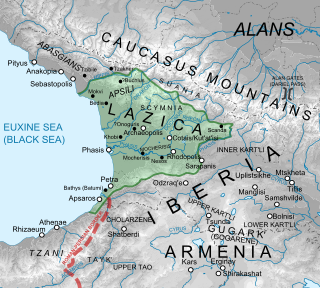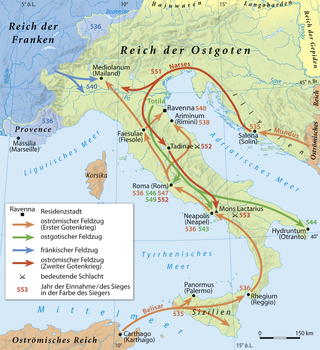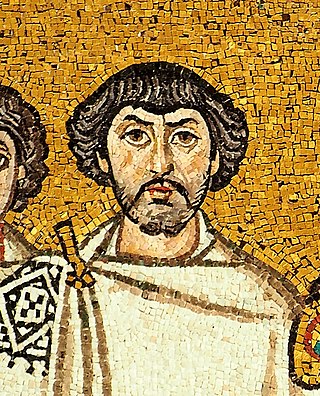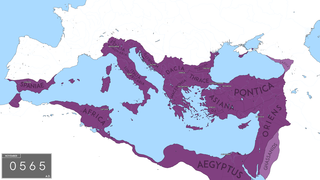Related Research Articles
The 540s decade ran from January 1, 540, to December 31, 549.

Narses was, with Belisarius, one of the great generals in the service of the Byzantine Emperor Justinian I during the Roman reconquest that took place during Justinian's reign. Narses was a Romanized Armenian. He spent most of his life as an important eunuch in the palace of the emperors in Constantinople.

Totila, original name Baduila, was the penultimate King of the Ostrogoths, reigning from 541 to 552 AD. A skilled military and political leader, Totila reversed the tide of the Gothic War, recovering by 543 almost all the territories in Italy that the Eastern Roman Empire had captured from his Kingdom in 540.
Ildibad was a king of the Ostrogoths in Italy in 540–541.

The Lazic War, also known as the Colchidian War or in Georgian historiography as the Great War of Egrisi was fought between the Byzantine Empire and the Sasanian Empire for control of the ancient Georgian region of Lazica. The Lazic War lasted for twenty years, from 541 to 562, with varying success and ended in a victory for the Persians, who obtained an annual tribute in exchange for ending the war. The Lazic War is narrated in detail in the works of Procopius of Caesarea and Agathias.

The Gothic War between the Eastern Roman Empire during the reign of Emperor Justinian I and the Ostrogothic Kingdom of Italy took place from 535 to 554 in the Italian Peninsula, Dalmatia, Sardinia, Sicily and Corsica. It was one of the last of the many Gothic Wars against the Roman Empire. The war had its roots in the ambition of the Eastern Roman (Byzantine) Emperor Justinian I to recover the provinces of the former Western Roman Empire, which the Romans had lost to invading barbarian tribes in the previous century, during the Migration Period.
The First Siege of Rome during the Gothic War lasted for a year and nine days, from 2 March 537 to 12 March 538. The city was besieged by the Ostrogothic army under their king Vitiges; the defending East Romans were commanded by Belisarius, one of the most famous and successful Roman generals. The siege was the first major encounter between the forces of the two opponents, and played a decisive role in the subsequent development of the war.

The Battle of Sena Gallica, was a naval battle fought off the Italian Adriatic coast in the autumn of 551 between an East Roman (Byzantine) and an Ostrogoth fleet, during the Gothic War (535–554). It marked the end of the Goths' brief bid to deny the seas to the Romans, and the beginning of the Byzantine resurgence in the war under the leadership of Narses.

The sack of Rome in 546 was carried out by the Gothic king Totila during the Gothic War of 535–554 between the Ostrogoths and the Eastern Roman Empire. Totila was based at Tivoli and, in pursuit of his quest to reconquer the region of Latium, he moved against Rome. The city endured a siege lasting almost a year before falling to the Goths.

Flavius Belisarius, better known simply as, Belisarius, was a military commander of the Byzantine Empire under the emperor Justinian I. He was instrumental in the reconquest of much of the Mediterranean territory belonging to the former Western Roman Empire, which had been lost less than a century prior.

The Byzantine Empire under the Justinian dynasty underwent a golden age, beginning in 518 AD with the accession of Justin I. Under the Justinian dynasty, particularly the reign of Justinian I, the empire reached its greatest territorial extent since the fall of its Western counterpart, reincorporating North Africa, southern Illyria, southern Spain, and Italy into the empire. The Justinian dynasty ended in 602 with the deposition of Maurice and the ascension of his successor, Phocas.

The city of Rome was besieged in AD 549–550 by the Ostrogoths, led by Totila, during a campaign to recapture Italy from the Byzantine Empire. After Totila imposed a blockade, soldiers from the city's garrison opened the gates to him. Many of the male inhabitants were killed in the city or while attempting to flee. The city was afterwards repopulated and rebuilt.
Justin was a 6th-century East Roman (Byzantine) general, who was active in the Gothic War in Italy under Justinian I.
John, the nephew of the rebel Vitalian, was an Eastern Roman general under Justinian I, who was active in the Gothic War in Italy and against the Gepids in the western Balkans. He was married to Justina, the daughter of Justinian's cousin Germanus.
Bessas was an Eastern Roman general of Gothic origin from Thrace, primarily known for his career in the wars of Justinian I. He distinguished himself against the Sassanid Persians in the Iberian War and under the command of Belisarius in the Gothic War, but after Belisarius' departure from Italy he failed to confront the resurgent Goths and was largely responsible for the loss of Rome in 546. Returning east in disgrace, despite his advanced age he was appointed as commander in the Lazic War. There he redeemed himself with the recapture of Petra, but his subsequent idleness led Justinian to dismiss him and exile him to Abasgia.
The siege of Auximus was a siege during Justinian’s Gothic War which took place in the year 539. It ended with the Belisarius’ Byzantine force victorious. The Gothic garrison surrendered the town and joined the Byzantines after negotiations. The siege lasted 7 months.
The siege of Urbinus also called Siege of Urbino or Siege of Urbinum took place in the year 538 during Justinian's Gothic War. Earlier, when John took Ariminum, he had bypassed Auximus and Urbinus which would have to be taken now to secure the road to Ravenna. The Gothic king, Witigis, had sent a man called Moras with 2.000 troops to defend the city. In the year 538, the Byzantine commander, Belisarius went to besiege the town while another strong Byzantine contingents besieged Urviventus. The forces of Narses and John, other Byzantine commanders, who were undermining Belisarius' authority, joined him in this venture. Thinking the defenders would be terrified on seeing the Byzantine army, Belisarius sent envoys offering the garrison a chance to surrender. Narses and John set up camp separately form Belisarius, on the other side of the town, and, after negotiations with the garrison failed, totally abandoned the siege. They declared taking the town impossible and moved to capture Aemilia but while Belisarius was preparing to assault the town surrendered due to the failure of its spring. Astonished by such success, Narses sent John to capture Caesena but this assault failed. John then moved to and managed to capture Forocornelius. After this siege Belisarius moved to support in the siege of Urviventus, also capturing that city shortly after.
The siege of Ravenna of 539-540 took place during Justinian’s Gothic War. After clearing out Ariminum, Urviventus, Urbinus and Auximus the road to Ravenna was open to the Byzantines. In late 539 or early 540 Belisarius, victor of engagements like Dara, Ad Decimum and Rome, marched on Ravenna while Vitalius was already in the area. Vitalius discovered a grain shipment destined for Ravenna and captured it. When news of the siege spread many Gothic garrisons began to surrender. The city itself was taken when Belisarius was offered the Ostrogothic throne and faked acceptance.
Odolgan was a Hun commander serving under the Byzantine Empire. He was the commander of the garrison of Perugia.
References
- 1 2 3 Bury, J. B. (1958). History of the Later Roman Empire, Vol. 2 From the Death of Theodosius I to the Death of Justinian. Dover Publications. p. 248. ISBN 9780486203997 . Retrieved 26 October 2022.
- 1 2 Hodgkin, Thomas (1885). Italy and Her Invaders: The imperial restoration, 535-553. 1885. Clarendon Press. p. 754. Retrieved 26 October 2022.
- ↑ Hughes, Ian (2009). Belisarius The Last Roman General (in French). Pen & Sword Books. ISBN 9781844689415 . Retrieved 26 October 2022.